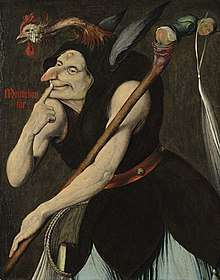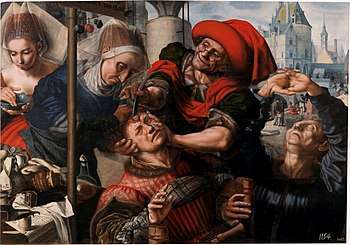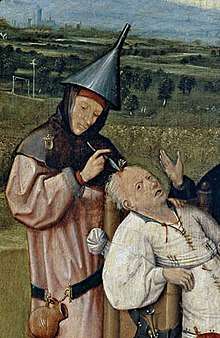Stone of madness
The stone of madness, also called stone of folly, was a hypothetical stone in a patient's head, thought to be the cause of madness, idiocy or dementia. From the 15th century onwards, removing the stone by trepanation was proposed as a remedy.[1][2] This procedure is demonstrated in the painting The Extraction of the Stone of Madness by Hieronymus Bosch.[3]
Gallery
 Quentin Massys, An Allegory of Folly (early 16th century). The fool has a "stone of folly" in his forehead.
Quentin Massys, An Allegory of Folly (early 16th century). The fool has a "stone of folly" in his forehead. Pieter Huys, A surgeon extracting the stone of folly
Pieter Huys, A surgeon extracting the stone of folly Jan Sanders van Hemessen, 1550s
Jan Sanders van Hemessen, 1550s After Hieronymus Bosch, 16th century
After Hieronymus Bosch, 16th century Pieter Jansz. Quast,
Pieter Jansz. Quast,
Die Steinoperation, ca 1630
gollark: Anyway,```scheme(define actually-forgiving-grudge (lambda (x y) (let* ( (defection-count (length (filter (lambda (m) (= m 1)) x))) (lookback (+ 1 (inexact->exact (floor (expt defection-count 1.5))))) (result (if (memq 1 (take lookback x)) 1 0)) ) result)))```did beat tit-for-tat but not forgiving-grudge or the regular one.
gollark: So you DID read my link!
gollark: Is your strategy an extended "democracy" thing or what?
gollark: Okay, so I think I'll do the forgiving one by... taking the total defection count, and looking back (SOME VALUE)^that entries for badness, and defecting if detected.
gollark: I'll make `actually-forgiving-grudger`.
References
- Vigué, Jordi (2002). Great Masters of Western Art. Watson-Guptill. p. 71. ISBN 0-8230-2113-0.
There was a popular belief that a so-called "stone of madness" caused idiocy or dementia. To cure this, it was believed necessary to remove a section of the ...
- Shorter, Edward (1997). A History of Psychiatry. Wiley. p. 225. ISBN 0-471-24531-3.
stone of madness.
- Povoledo, Elisabetta (October 27, 2008). "In Rome, a New Museum Invites a Hands-On Approach to Insanity". The Economist. Retrieved 2008-10-28.
The logo of the Mind’s Museum is an overturned funnel. It is a reference to a 15th-century painting by Hieronymus Bosch that depicts a doctor using a scalpel to extract an object (the supposed “stone of madness”) from the skull of a patient. The doctor is wearing a funnel as a hat.
This article is issued from Wikipedia. The text is licensed under Creative Commons - Attribution - Sharealike. Additional terms may apply for the media files.
